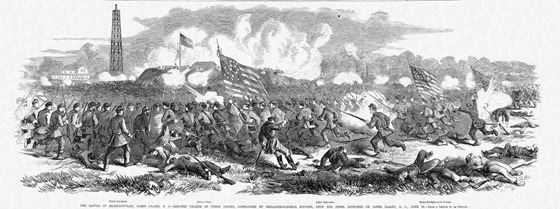Bayonet Charge at Secessionville, SC, June 16, 1862 – Frank Leslie’s Illustrated Newspaper
Click on image to view larger version.
The Battle of Secessionville.
(from The days of the Swamp Angel by Mary Hall Leonard, 1914)
Since the taking of Port Royal the United States had gradually gained possession of nearly all the Sea Islands south of Charleston, as the Confederates left them one by one. Now it was said at the War Department in Washington that if the Union forces were suddenly concentrated on James Island, and if Fort Johnson could be taken, the city itself might be reached by Federal batteries. So from Hilton Head the troops embarked, landing at Old Battery on the Stono River. But by this time the Confederates had erected the new fortification, afterward called Fort Lamar, to keep off the invaders. The commander of the Union forces now attempted by a sudden overwhelming movement to capture this fort.
On the morning of June 16 the people of Charleston were startled by the discharge of guns and by smoke in the direction of James Island. Messengers soon began to arrive in the city and telegrams from the nearest points came pouring in.
The whole town was in a tremor of excitement. People thronged the streets, watching the smoke of the battle, listening to the sounds of the firing, and eagerly asking one another for news.
Thus was precipitated the battle of James Island, or Secessionville, resulting in the repulse of the United States troops, who fell back, leaving their killed and wounded on the field.
With the retreat of the invaders a great wave of rejoicing swept over the community. But there was no time for idle exultation. The wounded must be cared for. Mourners must be comforted. Preparations must be made for further defense in case of renewed attack.
Frampton Place, near the scene of the battle, was at once made into a temporary hospital, though as soon as possible the wounded and the prisoners were brought into the city. The hospitals were filled with the injured of both armies, and many of the ladies of Charleston found a new field for service as volunteer nurses. As for Dr. MacPherson, he seemed to be in a dozen places at once, attending personally to the most important cases, and organizing and superintending the work of other surgeons.
To the relief of the Confederates, the Northern general did not renew the attack. The defeat at Secessionville terminated this invasion, and no more attempts were made to enter Charleston from the rear.



